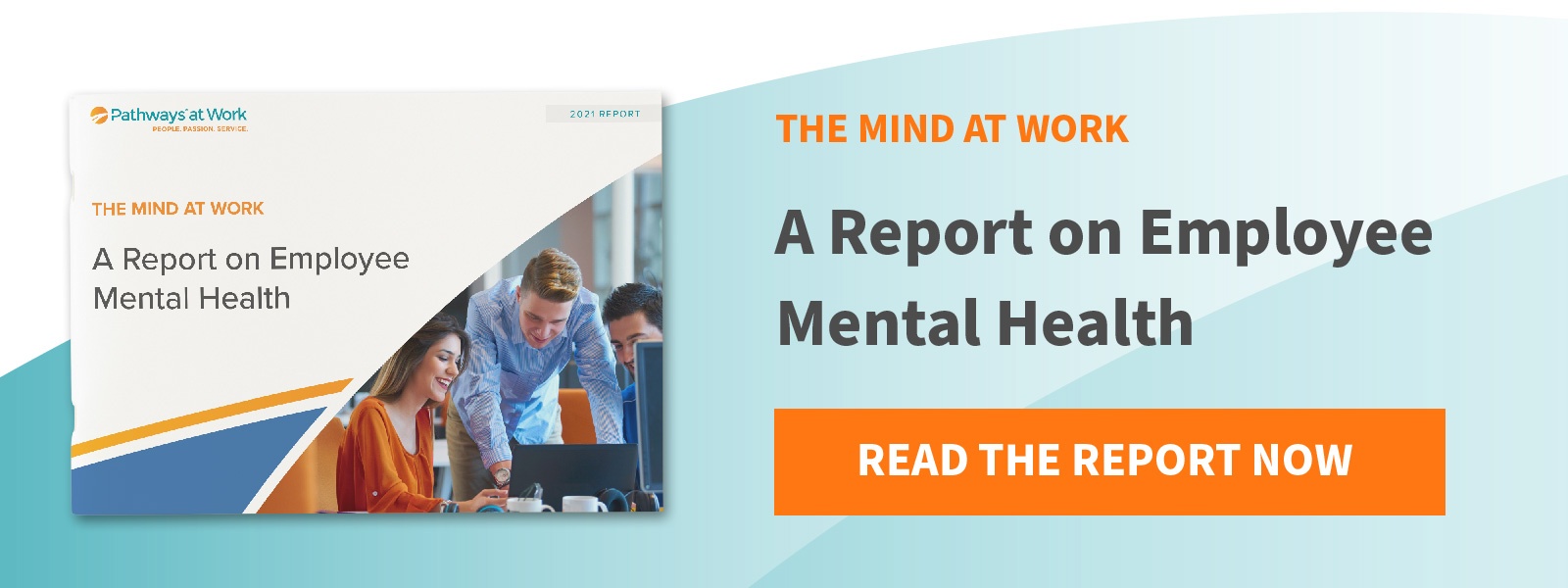How HR Can Promote a Culture of Well-Being
Company culture is the most important factor in any organization’s performance— it encompasses the shared values, expectations, and attitudes held by team members that influence how they do their jobs every day. With the alarming and disruptive employee trends and labor statistics, HR teams are looking for ways to revitalize their workplace cultures.
The dire state of employee well-being, along with record rates of turnover, has brought company culture to the forefront of HR strategy this year. According to a recent survey by Pathways, over 70% of employees expressed concern with depression, and 90% were concerned with burnout. This number is even more striking considering that a record-setting number of Americans are quitting their jobs. According to the Department of Labor, 4.4 million people quit their jobs in September 2021.
The Great Resignation can be attributed to multiple factors, but it’s mainly driven by company mindsets that underestimate the impact of culture on employees’ well-being and morale. However, amid increasing turnover rates and declining mental health of employees— there is a bright side. HR teams and leaders have the opportunity to “reset” the core pillars of how their workplace operates. It’s a chance to create a culture of well-being— one that engages employees authentically and attracts new talent.
What is a Culture of Well-Being?
A culture of well-being prioritizes employee mental health and offers support so that team members can thrive at work and home. To build a culture around well-being, your HR team needs a holistic understanding of employee well-being. Although employers often focus on employees’ physical wellness, emotional and mental health are key to their well-being, as are financial, social, and spiritual health.
In the workplace context, consider how your HR team can promote all aspects of employee well-being. Fostering a culture of well-being at work involves both a bottom-up and top-down approach. Messaging, resourcing, and modeling well-being from leadership are critical. However, invested employees who champion well-being at their workplace will ultimately move the needle for improving culture. For HR Teams, this movement starts with a solid understanding of the current status of employee well-being.
How to Measure Employee Well-Being
To begin building a culture of well-being, your HR team needs to measure employee well-being at your organization. Start by collecting feedback from employees about their well-being and whether your organization offers them sufficient support currently. A survey of employees should ask them about their emotional and physical health, relationships with coworkers and leadership, stress levels, financial worries, and more.
Your initial survey results will reflect what is missing from your organization’s current culture and what aspects support employees best. In addition, it will yield insight into whether employees feel your organization invests in their well-being and any concerns about your current culture. From there, you can begin mapping out your plan to create a culture of well-being with the strategies outlined below.
Building a Culture of Well-Being
With feedback about how your culture can support employees more effectively, you can begin planning well-being initiatives. Each well-being program you launch should be part of an overall strategy that promotes employee health. In addition, your well-being strategy will include specific support and benefits you’ll provide to cultivate holistic employee wellness in the workplace.
Each organization’s culture is unique, and employee feedback about well-being will differ depending on your industry and business. However, creating a solid strategy includes foundational elements. Here are five ways your HR team can promote a workplace culture of well-being by supporting the needs of your people:
Use Mindful Communication in the Workplace
Mindful communication is a significant component of creating a culture of well-being at work; as communication dictates behaviors, how and what members of your organization communicate ends up shaping your entire culture. For example, mindful communication can change the way employees feel about going to work every day and improve their relationships with their coworkers, leaders, and organizations.
Mindful communication includes five components: active listening, practicing non-judgment, showing understanding, expressing empathy, and remaining present. Instead of preparing your response, listen actively to the speaker and show curiosity while leaving personal judgments aside. Listen to understand rather than to respond immediately.
When it’s your turn to speak, ask clarifying questions summarizing what the speaker has said and empathize with their position. This approach to communication allows you to stay present in the conversation and ensures the speaker feels heard and understood.
Unlike other aspects of your strategy, a top-down approach is necessary to ensure mindful communication becomes the norm in your workplace. Your HR department should work with leaders and managers within your organization to teach and practice communication when they interact with team members.
Implement Mental Health Training in the Workplace
Company cultures can best promote well-being by offering employees training to manage their mental health. Mental Health Training in the workplace expands beyond EAPs and other benefits by training employees to manage their emotional and mental health proactively rather than reactively. Educating employees about recognizing the common signs of mental health issues and actionable skills to help manage their stress and well-being is crucial to healthy work cultures.
Equipping employees with the knowledge and tools to actively care for their mental health is the foundation of healthy work cultures. Therefore, an effective mental health training program is ongoing and provides team members with on-demand resources and tools to manage their mental health daily. It also helps promote healthier work-life balance, employee engagement, relationships with coworkers, and retention.
When employees feel that their organization is invested in their well-being and provides ongoing support, they contribute positively to their work environment. Employees can help build a culture of well-being if they have the tools and resources to manage their own. These employees contribute to a cultural norm of daily well-being “practice,” encouraging others to do the same. Self-compassion and compassion for others become ingrained as employees feel supported and safe discussing and practicing emotional wellness.
Promote Employee Financial Health Benefits
Holistic well-being in the workplace includes the financial health of your employees. As employees’ jobs are inherently linked to their financial situation, their financial stress often shows up in the workplace. Financial health is vital right now, with 65% of employees reporting some level of financial stress this year. Your HR team can offer employees the support and education they need to improve their financial wellness and well-being at work. To promote better financial health, take a look at your existing offerings and determine what resources already exist.
The financial institution your organization has partnered with to handle all things related to compensation likely has financial wellness resources for employees. For example, big and small financial institutions (e.g., Regions Bank) offer free employee financial wellness programs that provide education programs and coaching sessions to help employees improve their financial health. Be sure to regularly promote this to employees, whether through an annual week-long financial boot camp or on a quarterly benefits webinar.
Center Your Wellness Programs on the Mind-Body Connection
Your organization has likely been running wellness programs for decades— they’re a great way to improve employees’ health and save on health-care-related costs. However, traditional wellness programs focus on physical health metrics without understanding that they depend on a solid mind-body connection.
For example, if your organization puts on company-sponsored walkathons to reduce cardiovascular disease and promote heart health, it’s not focusing on the whole picture of employee health. Stress is the leading cause of high blood pressure, cardiovascular disease, and strokes in the U.S. While regular walking is an effective stress reduction technique, it isn’t a comprehensive stress management strategy.
Be sure that your wellness programs reinforce and address the mind-body connection. For example, if your wellness program is only focusing on later-stage outcomes (i.e., high blood pressure), it’s reactive rather than proactive. On the other hand, focusing on the mind-body connection means that your wellness program includes preventive mental health measures that improve physical health. For example, add regular mindfulness meditation sessions or controlled breathing practice in addition to a walkathon.
Messaging is also in your control. You can remind employees how stress reduction influences physical health. For example, a walkathon can be “doubly” promoted for this mind-body connection. Promoting mental and physical health together makes for more comprehensive wellness programs and elevates well-being within your culture.
The Cost of Company Culture & Well-Being at Work
Promoting well-being at work is a valuable investment in the people who make your company successful and keep operations running. It’s not just about the health of your employees; a culture of well-being can improve your organization’s health, too. According to Deloitte research, 94% of executives believe that company culture is vital to their organization’s success. And employees agree— the same study found that 88% of employees believe that culture determines their company’s performance.
Beyond common-held beliefs, creating a culture of well-being can improve your company’s bottom line through improved employee retention, reduced absenteeism, and fewer health-care-related costs. Employees who work in an uneasy or toxic work culture are 50% more likely to experience health problems. When employees experience health problems more frequently, it leads to higher rates of absenteeism and costs companies more money in health-care-related costs.
Another study found that the probability of employee turnover is 37% higher in unhealthy company cultures. This study was conducted long before the Great Resignation, which has likely increased turnover risk in unhealthy company cultures. Furthermore, workplace culture influences employee engagement levels. A Gallup study found that workplaces that promote well-being saw greater employee engagement.
It’s no secret that well-being is top of mind for employees, and HR teams focused on creating a culture of well-being are positioning their organization for long-term success. If your organization needs help promoting well-being as part of a more significant cultural initiative, our behavioral health experts can help.
Our Pathways at Work team will work with your leaders to create a fully customized workplace mental health training program that puts well-being at the heart of what you do. Reach out here to begin building your culture of well-being today.



.jpg)